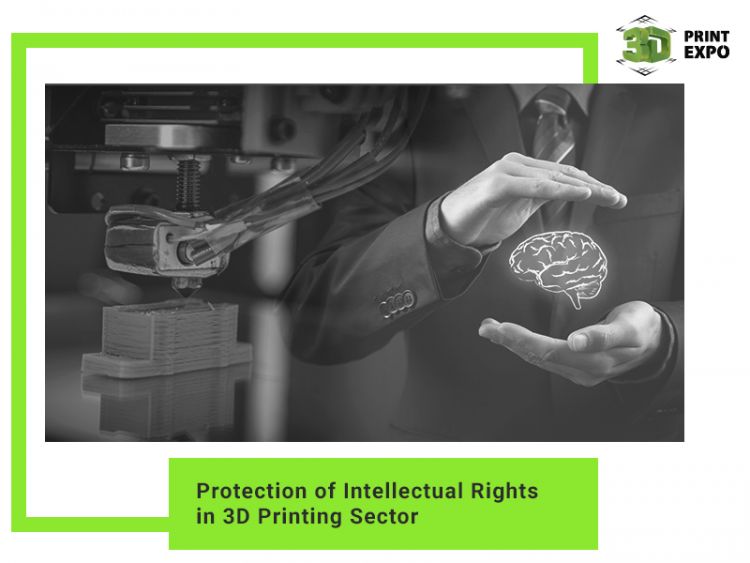Protection of Intellectual Rights in 3D Printing Sector

Additive technologies and new solutions in this area affect not only industrial processes and manufacturing. The development of 3D printing also involves intellectual property: it is referred to strategies for protecting company rights, products, and related law practice.
Additive technology potential
3D printing, also known as additive manufacturing, allows creating a real-life material object out of a digital three-dimensional pattern. A 3D printing device produces items by melting materials layer by layer and exposes them to the temperature, chemical substances, or light.
Various materials can be used for printing: plastics, metals, foodstuff, and even cell tissue. 3D printing makes production simpler, faster, and economically-viable, as additive technologies help to fabricate objects without utilizing the whole technical complex.
Over recent years, the advancement of three-dimensional printing processes has been entering a new level, as patents for some 3D printing methods (e.g. for Selective Laser Sintering) have been no longer in force since 2014. It encourages the wide promotion of 3D technologies and makes printing devices more affordable.
Besides, 3D technologies are referred not only to manufacturing but also to digital areas. Therefore, it has become much easier to illegally copy any objects and distribute their accurate models. These purposes require 3D scanners allowing any person to read out forms of off-the-shelf products, create 3D drafts, and distribute them. This causes certain inconveniences attributed to the protection of intellectual property rights.
Intellectual property risks

The core advantage of 3D printing application is the possibility to produce almost all items at minimum time and cost expenses. It allows people not to buy certain goods but to make them at home. Unfortunately, if objects are produced not for commercial purposes, it is quite difficult to protect the rights for an idea and technology.
It is nearly impossible to forbid printing stuff for your own purposes or impose a penalty for such actions. It is much easier to combat the violation of patents and author's rights if a 3D pattern is applied commercially. For example, producing copies of a certain product for distribution and sales. The risk group includes industrial samples, which design can be scanned and used in the future.
Vulnerability of patents for 3D models
Item design can be protected by patents, but this way is hardly perfect. One can try to cheat such a document by adding several small details to the model without changing its feature set. Risks of illegal copying using 3D devices are different for various types of products.
For instance, the risk is not pretty high for aviation and pharmaceuticals where manufacturing is extremely complicated and expensive. However, the automotive industry and related production of ordinary components are within the high-risk area.
3D printing patenting issues are also related to modeling of new items and protection of the intellectual property rights for innovative solutions. Developing 3D patterns of new objects, you should check whether this product is protected by the author’s right and carry out a thorough patent search.
Protection of author’s rights in 3D printing
3D models, particularly those made using three-dimensional printing, can be protected as:
- copyright objects;
- objects of patent law.
Objects of patent law mean inventions, useful models, and industrial samples. The patent law protects technological solutions and item design from illegal recreation, but it does not prohibit dispersing information about such solutions. In this case, it prohibits producing certain objects using 3D printing but does not prevent the distribution of their 3D models on the Internet.
Three-dimensional patterns for 3D printing are not technological solutions and are not objects of patent law. Thus, what can be applied here is the author and legal regime of the protection of intellectual rights. The copyright law in the Russian Federation protects scientific, literary, and fictional works. According to the Civil Code, concepts, ideas, discoveries, and problem solving techniques are not considered to be copyright objects.
At the same time, this option has a single considerable disadvantage: the duration of copyright is much longer than the similar period of the patent law, which can become a problem for the additive technology industry. Too long protection time of the author's right for 3D printed objects can slow down the evolution of the economy in general and the additive technology sector in particular.
3D models need its own legal protection tool that will prohibit distributing information on the Web and will be able to function within terms specific to the patent protection.

Changes in legal sphere caused by 3D printing
The rapid growth of additive technologies will affect the intellectual right area and set new goals, i.a. developing standards of intellectual property application in terms of three-dimensional printing. Moreover, 3D technologies can result in other breakthroughs in this field.
Companies will establish clearer rules of manufacturing security, technology protection from unauthorized duplication using additive technologies.
One will introduce more and more solutions allowing to digitize images faster and create their three-dimensional models. It will cause the necessity for changing the regulation of the author’s right for 3D files.
Protection of consumer rights and legal liability for defected goods will become a more critical issue. In case of harming people, one will have to identify a guilty party: a product manufacturer, a 3D printer provider, a printing material producer, or a three-dimensional model author.
Conclusion
The modern legal sector frequently fails to advance as rapidly as it is required by the growth of new technologies: the Internet of Things, data transmission, 3D printing, etc. To provide the maximum protection of additive technology intellectual rights, the Civil Code of the Russian Federation needs a range of introductions aimed at precluding the illegal distribution of three-dimensional models on the Web. Furthermore, one should consider the option of equating 3D patterns with copyright objects.







